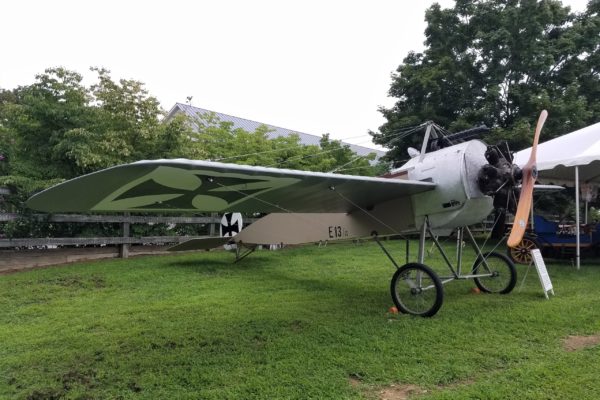
Fokker E.I
- : Germany
- : 1914
- : Oberursel
- 100
- 83 mph (133 km/hr)
- 1400 lbs (635 kg)
- : Static Exhibit
- : Reproduction
Fokker Eindecker aircraft were a series of German WWI monoplane, single-seat fighters designed by Dutch engineer, Anthony Fokker. The first purpose-built German fighter, it was the first aircraft to be fitted with a synchronization gear, allowing the pilot to fire bullets through the propeller’s arc without striking the blades. This innovation gave the Germans air-superiority from July 1915 into early 1916. This period became known as the “Fokker Scourge”, when many allied aircraft and airmen fell victim to machine-gun armed Eindeckers.
Developed from a French Morane Saulnier type L purchased by Anthony Fokker, it underwent several modifications throughout its development and was at first called the M5.
Around the same time Fokker was called upon to develop a method of firing the bullets of a machine gun through the arc of an aircraft’s propeller. The French were working on a similar arrangement and a Morane Saulnier piloted by famed aviator Roland Garros was captured with a rough prototype (see Morane Saulnier N). Fokker developed his famous synchronization gear system and installed it on a Fokker M5k monoplane, which soon became the Fokker E.I. It was the first true fighter aircraft of the war and set the stage for a battle of technological superiority that directly influenced the rapid development of aircraft design for the duration of the war.
The Aerodrome’s Fokker E.I is a reproduction that was built by Robert Sebring in the 1980s and purchased by Cole Palen in the early 1990s. During the sales negotiations, it was involved in a taxiing mishap which destroyed the landing gear, rudder and nose. In the fall of 2013, Aerodrome volunteers started to build the missing parts and by July of 2017 the newly finished Eindecker was placed on exhibit in the museum. The color scheme represents Fokker E.I “E13/15.” This machine is believed to have been flown by both Oswald Boelcke and Max Immelmann, two of Germany’s earliest and most legendary pilots.
Click for more information about the Fokker E.I
